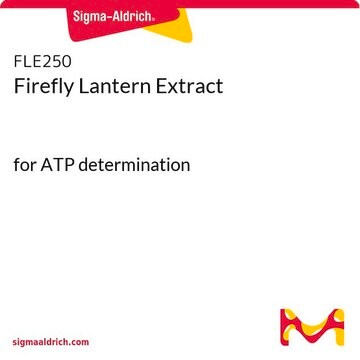R1258
Kpn I from Klebsiella pneumoniae
Restriction Enzyme
Anmeldenzur Ansicht organisationsspezifischer und vertraglich vereinbarter Preise
Alle Fotos(1)
About This Item
Empfohlene Produkte
Qualität
for molecular biology
Form
buffered aqueous glycerol solution
Konzentration
10,000 units/mL
Versandbedingung
wet ice
Lagertemp.
−20°C
Suchen Sie nach ähnlichen Produkten? Aufrufen Leitfaden zum Produktvergleich
Spezifität
Recognition sequence: 5′-GGTAC/C-3′
Cutting results: a 2-10-fold Kpn I overdigestion of 1 μg λ DNA substrate results in 100% cutting
Heat inactivation: 65 °C for 15 minutes.
Cutting results: a 2-10-fold Kpn I overdigestion of 1 μg λ DNA substrate results in 100% cutting
Heat inactivation: 65 °C for 15 minutes.
Anwendung
KpnI is a DNA restriction enzyme that is used in molecular biology research to cleave DNA at the recognition sequence 5′-GGTAC/C-3′ to generate DNA fragments with 3′-cohesive termini.
Sonstige Hinweise
Supplied with 10x Restriction Enzyme Buffer SL (B3782)
Comment: Kpn I shows abnormal DNA cleaving patterns (star activity) in reactions containing high (>5%) glycerol, >5% (v/v); excess enzyme and high pH (>8.0).
The enzyme will not cleave DNA containing 3′-residue of 5-methylcytosine.
The enzyme will not cleave DNA containing 3′-residue of 5-methylcytosine.
Physikalische Form
Solution in 20 mM Tris-HCl, pH 7.5, 0.1 mM EDTA, 50 mM NaCl, 10 mM 2-mercaptoethanol, 50% glycerol (v/v), 0.01% polydocanol (v/v) at 4°C
Ähnliches Produkt
Lagerklassenschlüssel
12 - Non Combustible Liquids
WGK
WGK 1
Flammpunkt (°F)
Not applicable
Flammpunkt (°C)
Not applicable
Analysenzertifikate (COA)
Suchen Sie nach Analysenzertifikate (COA), indem Sie die Lot-/Chargennummer des Produkts eingeben. Lot- und Chargennummern sind auf dem Produktetikett hinter den Wörtern ‘Lot’ oder ‘Batch’ (Lot oder Charge) zu finden.
Besitzen Sie dieses Produkt bereits?
In der Dokumentenbibliothek finden Sie die Dokumentation zu den Produkten, die Sie kürzlich erworben haben.
J Tomassini et al.
Nucleic acids research, 5(11), 4055-4064 (1978-11-01)
We have determined the recognition sequence of the restriction endonuclease KpnI, previously isolated from Klebsiella pneumoniae. The enzyme cleaves the twofold rotationally symmetric sequence (see book for formula) at the positions indicated by the arrows, producing 3' protruding cohesive ends
T Welsch et al.
American journal of physiology. Renal physiology, 281(4), F769-F777 (2001-09-13)
Mice lacking the 80-kDa CD2-associated protein (CD2AP) develop progressive renal failure that starts soon after birth with proteinuria and foot process effacement by unknown mechanisms. CD2AP has been identified and cloned independently by virtue of its interaction with the T
Karel De Gendt et al.
Proceedings of the National Academy of Sciences of the United States of America, 101(5), 1327-1332 (2004-01-28)
Androgens control spermatogenesis, but germ cells themselves do not express a functional androgen receptor (AR). Androgen regulation is thought to be mediated by Sertoli and peritubular myoid cells, but their relative roles and the mechanisms involved remain largely unknown. Using
Jaroslav Jelinek et al.
Epigenetics, 7(12), 1368-1378 (2012-10-19)
Genome wide analysis of DNA methylation provides important information in a variety of diseases, including cancer. Here, we describe a simple method, Digital Restriction Enzyme Analysis of Methylation (DREAM), based on next generation sequencing analysis of methylation-specific signatures created by
Cong Zhu et al.
Nucleic acids research, 41(4), 2455-2465 (2013-01-11)
Zinc-finger nucleases (ZFNs) have been used for genome engineering in a wide variety of organisms; however, it remains challenging to design effective ZFNs for many genomic sequences using publicly available zinc-finger modules. This limitation is in part because of potential
Unser Team von Wissenschaftlern verfügt über Erfahrung in allen Forschungsbereichen einschließlich Life Science, Materialwissenschaften, chemischer Synthese, Chromatographie, Analytik und vielen mehr..
Setzen Sie sich mit dem technischen Dienst in Verbindung.







